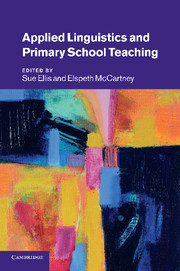Book contents
- Frontmatter
- Contents
- List of figures
- List of tables
- Notes on contributors
- Preface
- Editors' notes and conventions
- Introduction
- Part I Policy and diversity in the twenty-first-century primary school
- Part II The range and focus of applied linguistics research
- Introduction to Part II
- 6 Grammar for designers: how grammar supports the development of writing
- 7 The use of corpus-based approaches in children's knowledge about language
- 8 Words and pictures: towards a linguistic understanding of picture books and reading pedagogy
- 9 From storytellers to narrators: how can the history of reading help with understanding reading comprehension?
- 10 Talk about text: the discursive construction of what it means to be a reader
- 11 Why we need to know about more than phonics to teach English literacy
- 12 Understanding children's reading comprehension difficulties
- 13 Classroom discourse: the promise and complexity of dialogic practice
- 14 Pedagogy and bilingual pupils in primary schools: certainties from applied linguistics
- Part III Empowering teachers and teachers' use of knowledge
- References
- Index
12 - Understanding children's reading comprehension difficulties
Published online by Cambridge University Press: 26 April 2011
- Frontmatter
- Contents
- List of figures
- List of tables
- Notes on contributors
- Preface
- Editors' notes and conventions
- Introduction
- Part I Policy and diversity in the twenty-first-century primary school
- Part II The range and focus of applied linguistics research
- Introduction to Part II
- 6 Grammar for designers: how grammar supports the development of writing
- 7 The use of corpus-based approaches in children's knowledge about language
- 8 Words and pictures: towards a linguistic understanding of picture books and reading pedagogy
- 9 From storytellers to narrators: how can the history of reading help with understanding reading comprehension?
- 10 Talk about text: the discursive construction of what it means to be a reader
- 11 Why we need to know about more than phonics to teach English literacy
- 12 Understanding children's reading comprehension difficulties
- 13 Classroom discourse: the promise and complexity of dialogic practice
- 14 Pedagogy and bilingual pupils in primary schools: certainties from applied linguistics
- Part III Empowering teachers and teachers' use of knowledge
- References
- Index
Summary
Introduction
In the early stages of learning to read, children must learn to map letters onto sounds so that they can decode and recognise words. However, the ultimate goal of reading is to understand the messages conveyed by text, and simply being able to read words and texts accurately is not sufficient for comprehension to occur. As children move through the school years, access to the curriculum will increasingly rely on reading comprehension. Children with poor reading comprehension skills will struggle to learn from what they read, placing them at a disadvantage that may have wide-ranging educational consequences. The aims of this chapter are to raise awareness of children's reading comprehension difficulties, indicate some of the applied linguistic knowledge that can help primary teachers better understand them and emphasise the importance of monitoring and supporting reading comprehension skills in the classroom. In the first section, we review research on some of the factors that underpin reading comprehension, with particular reference to ‘poor comprehenders’, children who show impaired reading comprehension despite age-appropriate word recognition abilities. We then consider the educational implications of being a poor comprehender and present some recommendations for the assessment of reading comprehension abilities in school settings.
Explaining children's reading comprehension difficulties
The Simple View of Reading (Gough and Tunmer 1986) describes two potential barriers to reading success: difficulties with decoding and difficulties with language comprehension. Children's skills can vary continuously across these two dimensions, resulting in four extreme reading profiles.
- Type
- Chapter
- Information
- Applied Linguistics and Primary School Teaching , pp. 154 - 164Publisher: Cambridge University PressPrint publication year: 2011
- 2
- Cited by

